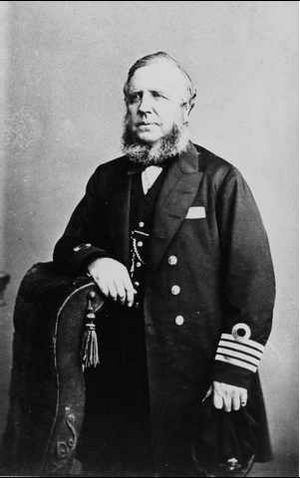William Pullen facts for kids
Quick facts for kids
Vice Admiral
William John Samuel Pullen |
|
|---|---|

William J.S. Pullen
(State Library of South Australia B5851) |
|
| Born | 1813 Devonport, Devon, England |
| Died | 1887 Torquay, England |
| Allegiance | |
| Service/ |
|
| Years of service | 1828–1836 & 1842-1870 |
| Rank | Vice admiral |
| Commands held | HMS North Star HMS Falcon HMS Cyclops HMS Terror |
| Battles/wars | Crimean War |
William John Samuel Pullen (born December 4, 1813 – died January 22, 1887) was a Royal Navy officer. He was the first European to sail along the northern coast of Alaska. This journey went from the Bering Strait all the way to the Mackenzie River in Canada.
His important 1849 trip was part of many efforts to find Sir John Franklin. Franklin was a famous explorer who had gone missing in the Arctic. Pullen's journey also helped explore the famous Northwest Passage.
Contents
William Pullen was born in Devonport, Devon, England. His father, William Pullen, was also a lieutenant in the Royal Navy.
William Jr. went to the Greenwich School. After finishing his education, he joined the Royal Navy in 1828.
Adventures in South Australia
In 1836, Pullen left the navy for a short time. He moved to South Australia to work with Colonel William Light on surveying land. He arrived in the colony in August 1836.
Pullen explored and mapped the area around the mouth of the Murray River. He is also known for discovering Port Adelaide. He sailed into this port on September 28, 1836. This was three months before the first Governor of South Australia arrived.
He also surveyed parts of the Lower Murray, Lake Alexandrina, and Port Elliot. His work greatly helped people understand the geography of the South Australian coast.
Several places in that area were named after him. These include Pullen Point, which is a tip of land near the Murray Mouth. There is also Pullen's Island, a small island at Port Elliot.
In 1840, Pullen led an expedition along the Coorong. He was investigating an incident involving survivors of a shipwreck. This event later affected his public reputation.
Exploring the Arctic
Pullen rejoined the Royal Navy in 1842. He was stationed on HMS Columbia, mapping the Saint John River and the Bay of Fundy. He was promoted to lieutenant in 1846. In 1845, he married Abigail Louisa Berton in Saint John, New Brunswick.
The Search for John Franklin
By 1848, it was clear that Sir John Franklin's expedition was lost in the Arctic. Three rescue missions were sent out. One went through the Bering Strait, where Pullen would play a key role.
HMS Plover and Herald were two ships involved in the search. Pullen joined the Plover in Honolulu in May 1849.
On July 27, 1849, Pullen was given an important task. He was ordered to take four boats and explore the coast all the way to the Mackenzie River. He had 2 officers and 22 men with him.
Sailing the Alaskan Coast
When Pullen reached Point Barrow, the ice was too thick. He sent the two largest boats back. He continued with 13 men, two smaller whale boats, and a local boat called an umiak.
He successfully reached the mouth of the Mackenzie River on September 2. Pullen was the first person to sail the entire Alaskan coast in one journey.
From the river mouth, he traveled upstream. He left most of his tired crew at a trading post called Fort McPherson. In early October, he reached Fort Simpson. There, he met another famous explorer, John Rae. Rae noted that Pullen's group was lucky to have good weather, as they did not have proper winter clothes.
A Second Arctic Journey
The next spring, Pullen's men rejoined him. He began his journey back to England. On the way, he received a message from the Admiralty. He had been promoted to commander! The message also ordered him to return to the Arctic to explore Banks Island and Victoria Island. His men bravely volunteered to go with him.
That summer, he took a york boat called Try Again and a Halkett boat. He traveled downriver and east along the coast. Near Cape Bathurst, he found the sea blocked by a huge mass of broken ice. On August 15, he had to turn back.
During his return, he discovered and named Pullen Island and Hooper Island. These islands are in the Mackenzie estuary in the Beaufort Sea. He spent the winter of 1850–51 at Fort Simpson. The next spring, he finally returned to London in October 1851.
Later Arctic Commands
After returning to England, Pullen was given command of HMS North Star. This ship was part of Edward Belcher's expedition to find John Franklin. The North Star was stationed at Beechey Island.
After several years, the North Star became the only ship from Belcher's expedition to survive. Belcher had ordered the other four ships to be left behind in the ice. Pullen and his crew returned to England in October 1854.
Pullen Strait, a narrow waterway between Cornwallis Island and Little Cornwallis Island, was named in his honor.
Later Career and Retirement
In 1855, Pullen commanded HMS Falcon. This ship was part of the operations during the Crimean War in the Baltic Sea. He was promoted to captain the following year.
His next active commands involved a lot of surveying work. He surveyed the Red Sea and Ceylon with HMS Cyclops. He also surveyed Bermuda with HMS Terror.
After several years working in Coast Guard posts, he retired in 1870. In retirement, he was promoted first to rear admiral, and then to vice admiral. He received a special pension in 1886 and passed away the next year in Torquay.
Images for kids


